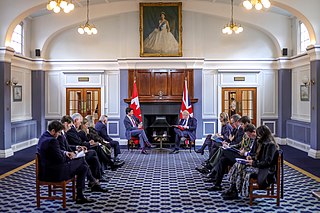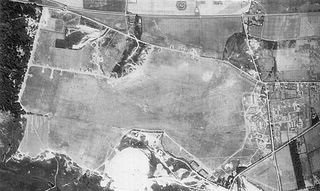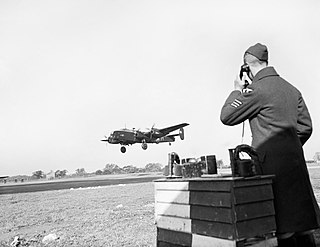
Royal Air Force Digby otherwise known as RAF Digby is a Royal Air Force station located near Scopwick and 11.6 mi (18.7 km) south east of Lincoln, in Lincolnshire, England. The station is home to the tri-service Joint Service Signals Organisation, part of the Joint Forces Intelligence Group of Joint Forces Command. Other units include the RAF Aerial Erector School, No. 54 Signals Unit and No. 591 Signals Unit.

Royal Air Force Northolt or more simply RAF Northolt is a Royal Air Force station in South Ruislip, 2 nautical miles from Uxbridge in the London Borough of Hillingdon, western Greater London, England, approximately 6 mi (10 km) north of Heathrow Airport. As London VIP Airport, the station handles many private civil flights in addition to Air Force flights.

Royal Air Force Hooton Park or more simply RAF Hooton Park, on the Wirral Peninsula, Cheshire, is a former Royal Air Force station originally built for the Royal Flying Corps in 1917 as a training aerodrome for pilots in the First World War. During the early/mid-1930s, it was one of the two airfields handling scheduled services for the Merseyside region. Hooton Park was home to No. 610 Squadron and, post Second World War, to No. 611 and No. 663 (AOP) Squadron.

Seletar Airport is a civilian international airport serving the north-east region of Singapore. It is located approximately 16 kilometres (9.9 mi) northwest from Changi Airport, the country's main airport, and about 16 kilometres (9.9 mi) north from the main commercial city-centre.
Royal Air Force Ringway or more simply RAF Ringway is a former Royal Air Force satellite station in Ringway, Cheshire, England, near Manchester. It was operational from 1939 until 1957. The site of the station is now occupied by Manchester Airport.
Castle Bromwich Aerodrome was an early airfield, situated to the north of Castle Bromwich in the West Midlands of England. The site now falls within the City of Birmingham.

Royal Air Force Horsham St Faith or more simply RAF Horsham St Faith is a former Royal Air Force station near Norwich, Norfolk, England which was operational from 1939 to 1963. It was then developed as Norwich International Airport.

Aston Down is in Gloucestershire, South West England, 2+1⁄2 miles (4 km) east of Minchinhampton, 6 miles (10 km) southeast of Stroud and 7 miles (11 km) west of Cirencester. The nearest settlement is the large village of Chalford, 1 mile (1.6 km) to the northwest.

Redhill Aerodrome is an operational general aviation aerodrome located 1.5 NM south-east of Redhill, Surrey, England, in green belt land.

Royal Air Force Warmwell or more simply RAF Warmwell is a former Royal Air Force station near Warmwell in Dorset, England from 1937 to 1946, located about 5 miles east-southeast of Dorchester; 100 miles southwest of London.

No. 607 Squadron is an auxiliary squadron of the Royal Air Force. It was formed in 1930 as a bomber unit in the Auxiliary Air Force and changed in 1936 to the fighter role. It fought in that role during the Second World War in Europe and Asia. After the war, in 1946, the squadron reformed as a fighter unit. Awarded the title Royal Auxiliary Air Force by King George in 1947, 607 Sqn was disbanded with all the other flying units of the RAuxAF on 10 March 1957. It reformed on 5 January 2015, as a General Service Support Squadron (GSS).

Royal Air Force Ouston or more simply RAF Ouston is a former Royal Air Force station that was located near the village of Stamfordham and the village of Heddon-on-the-Wall on Hadrian's Wall near Newcastle upon Tyne. It was built as a Second World War aerodrome and is today used by the British Army. Just north of the airfield is Richmond Hill, Northumberland, in the parish of Stamfordham.

Royal Air Force Keevil or more simply RAF Keevil is a former Royal Air Force station lying between the villages of Keevil and Steeple Ashton, about 4 miles (6.4 km) east of the town of Trowbridge, in Wiltshire, England.
Royal Air Force Andreas or more simply RAF Andreas is a former Royal Air Force station in the Isle of Man which was operational between 1941 and 1946. It was built in fields between Andreas and Bride in the north of the island. As was common practice, the station was named after the parish in which it was situated.
Royal Air Force Grangemouth or more simply RAF Grangemouth is a former Royal Air Force station located 3 mi (4.8 km) north east of Falkirk, Stirlingshire, Scotland.

No. 613 Squadron was an Auxiliary Air Force later Royal Auxiliary Air Force squadron formed on 1 February 1939 at the then new municipal airport at Ringway, nine miles south of Manchester. The squadron served at first in the army cooperation role, and later during the Second World War became a tactical bomber unit. After the war the squadron reformed as a fighter unit and as such flew until its last disbandment in March 1957.

Royal Air Force Llandow, or more simply RAF Llandow, is a former Royal Air Force station situated near the village of Llandow, Vale of Glamorgan, South Wales, 15 miles (24 km) west of Cardiff.
Royal Air Force Rhoose, or more simply RAF Rhoose, is a former Royal Air Force satellite station located near Rhoose, 10 miles (16 km) south west of Cardiff and 2 miles (3 km) east of RAF St Athan, Vale of Glamorgan, Wales. It was first used by an Operational Training Unit in April 1942, as additional space, until May 1943. The airfield then remained unused until February 1944, when an Air Gunnery School operated out of RAF Rhoose until August 1944. It was then placed into care and maintenance until transferred to RAF Maintenance Command in November 1944. After the Second World War, the airfield became a sub-site of a Maintenance Unit. The MU and airfield closed in 1948.

Royal Air Force Charterhall or more simply RAF Charterhall is a former Royal Air Force station located in the Scottish Borders and the historic county of Berwickshire between the village of Greenlaw and Duns. It was originally a First World War landing ground named Eccles Toft. The airfield was reconstructed in 1942 and was used mainly by No. 54 Operational Training Unit during Second World War. The RAF left in 1947 and the airfield was officially closed.

RAF Holme-on-Spalding Moor, or more simply RAF Holme is a former Royal Air Force station located in the East Riding of Yorkshire, England.
















